One of the greatest concerns most preppers have is how to feed themselves and their families after the collapse. It’s true that we are preparing as best we can now and those of us who have the means to do so have extra food stored away.
However, for some the ability to afford extra food is not a reality and even if you have a year’s worth or more of food stocked up, if the collapse is a permanent event, eventually you will be faced with a bare pantry and growling tummies.
When it is post-collapse and the pre-stocked food has run out, it is time to go out into nature and find what you need to survive. If you are still in the city, then you can find wild-growing edible plants in the urban environment.
You can learn about identifying urban wild edibles here. But if your food runs out and you can’t find any in the city, or you have already left the city, then you will need to hunt and forage to survive.
When it comes to foraging for wild plants, you need to know what you’re doing. There are a lot of poisonous plants out there that could make you sick or even kill you if you eat them! Some of these plants look a lot like the edible ones.
Knowing which plants to eat, what parts to eat, when to harvest them, and how to prepare them will help ensure your survival. Here is a list of plants that you can eat and how to identify them.
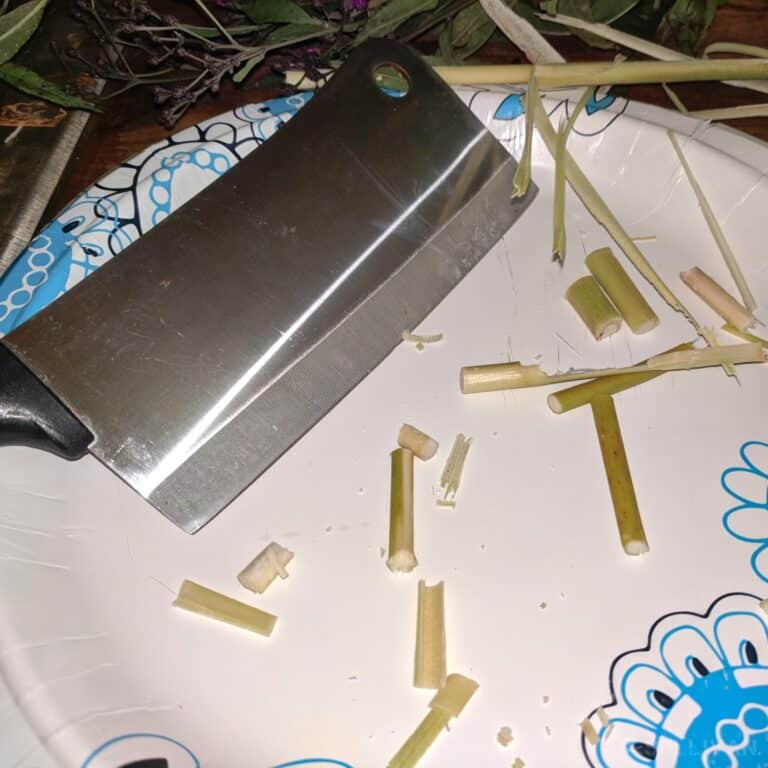
Cattail (Bulrushes)
Edible Parts:
- Leaves (lower parts): Salads
- Stems: Salads, soups
- Flowers (the cattail): Roasted, thickener in soups and stews
- Pollen: Added to food for extra nutrients
- Roots: Dried and ground into flour
Nutritional Content:
- Vitamin A, Vitamin K, Potassium, Sodium, Calcium, Magnesium, Phosphorous
Medicinal Value:
- Root can be used as a poultice against scrapes, burns, bruises, and insect bites.
When to Harvest:
- Anytime
Distinguishing Features:
- Tall, straight plant with large, cigar-shaped and –colored flower head
- Long, linear leaves 1-2 cm wide
- Found in swamps, wetlands, and any open wet areas
Need to Know:
- Useful to use material for baskets, mats
- Flower heads dipped in oil can be used as a torch
- Fluff in flower heads useful as packing material and stuffing for jackets, pillows, and mattresses
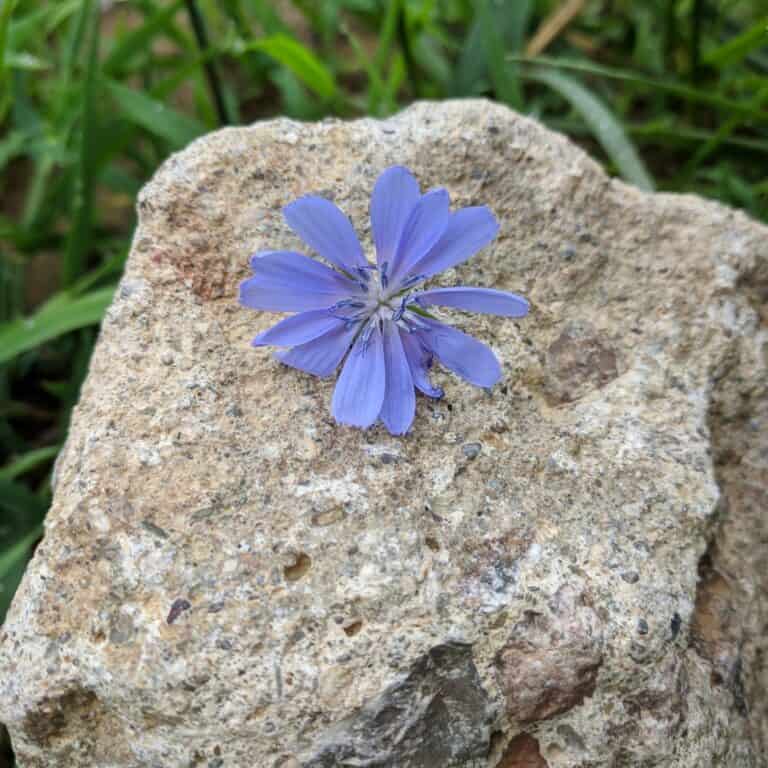
Chicory
Edible Parts:
- Leaves: Young leaves in salads; mature leaves as cooked green
- Roots: Make a good coffee substitute
- Flowers: Bitter, but edible
Nutritional Content:
- Vitamin A, Vitamin C, Vitamin K, Calcium, Phosphorous, Sodium, Potassium, Magnesium
Medicinal Value:
- Used against loss of appetite, stomach upset, constipation, rapid heartbeat, and disorders of the liver and gallbladder
- Leaves used for swelling and inflammation of the skin
When to Harvest:
- Spring or fall preferred; summer heat makes leaves bitter
Distinguishing Features:
- Purplish-blue flowers about 2-4 cm in diameter
- Branching plant, scraggly looking, often stands alone
- Grows in open areas, on roadsides, grassy areas, and field
Coltsfoot
Edible Parts:
- Flowers: Salads, tea, soups
- Young leaves: Salads, tea, soups (should be boiled and then washed to remove bitter taste); dried and burned to use as salt substitute
Nutritional Content:
- Vitamin C, Calcium, Potassium, Chloride
Medicinal Value:
- Flowers can be made into a cough syrup
When to Harvest:
- Flowers in early spring
- Leaves come after the flowers, in late spring
Distinguishing Features:
- Dandelion-like flower on slim stalk
- Flowers bloom and die before leaves appear
- Leaves are basal, hoof-shaped, waxy and smooth on surface and white hairs on underside
- Ditches, open areas, edges of the forest, areas of spring flooding
Need to Know:
- Limit use of coltsfoot to no more than 6 g (based on historical use) of the herb per day due to low levels of toxicity
- Roots potentially toxic
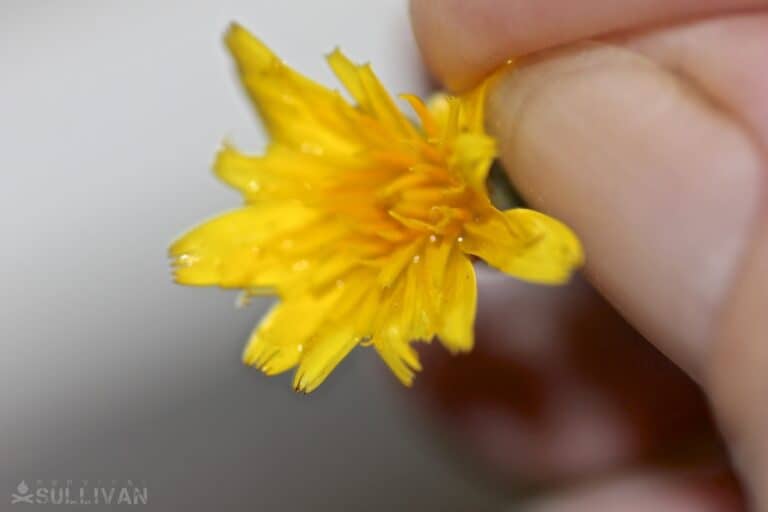
Dandelion
Edible Parts:
- Leaves: Salads, cooked greens, butter
- Flower: Salads, juiced
- Root: Coffee substitute, dried with leaves for tea
Nutritional Content:
- Vitamin A, Vitamin C, Vitamin K, Calcium, Potassium, Chloride, Magnesium, Sodium, Phosphorous
Medicinal Value:
- Used as a diuretic
- Leaves used to aid in digestion, get an appetite, and improve kidney function
- Flowers full of antioxidants
- Roots used to detox liver and gallbladder
When to Harvest:
- Anytime
Distinguishing Features:
- Bright yellow flower
- Deeply notched, hairless, basal leaves
- Central tap root
Need to Know:
- Good companion plant for gardens
Elderberry
Edible Parts:
- Berries: Raw (not preferred), jams, jellies, lies, wine
- Flowers: Salads
Nutritional Content:
- Vitamin A, Vitamin C, Vitamin B6, Vitamin B12, Calcium, Iron, Magnesium, Phosphorous, Potassium
Medicinal Value:
- Alleviates cold a flu by alleviating congestion and promoting sweating
- Used in treatment of bacterial sinusitis
When to Harvest:
- Spring for flowers
- Late summer for berries
Distinguishing Features:
- Shrub with smooth, gray-brown bark
- Umbrella-shaped flower clusters
- Purple-black berries in clusters
Need to Know:
- All parts of the plant, other than the flowers and berries, are poisonous
Garlic Mustard
Edible Parts:
- Flowers: Salads
- Leaves: Salads, tea
- Roots: spicy, like horseradish
- Seeds: raw, sprout, use in pesto and on salads
Nutritional Content:
- Vitamin A, Vitamin C, Vitamin E, Vitamin B, Calcium, Potassium, Copper, Iron, Manganese, Selenium, Magnesium, Omega-3 fatty acids
Medicinal Value:
- Used as an expectorant, stimulant, antiseptic
- Used to alleviate asthma and parasites and to heal wounds, such as cuts and skin ulcers
- Tea is a blood purifier
When to Harvest:
- Leaves can be harvested anytime, but will be bitter once summer heat arrives
- Roots before and after flower stalks develop
- Seeds in fall
Distinguishing Features:
- Broad leaves are heart- or kidney-shaped and have course, rounded teeth
- Tiny, white flowers with four petals shaped like a cross
- Odor of onion or garlic
- Found anywhere, including open, disturbed forests, wooded areas, ditches, swamps, and roadsides
Need to Know:
- Very invasive so harvest as much as you want
Horsetail
Edible Parts:
- All above-ground parts: Cooked or dried
Nutritional Content:
- Vitamin A, Vitamin C, Vitamin B2, Vitamin B3, Calcium, Chloride, Potassium, Magnesium, Phosphorous
Medicinal Value:
- Used to alleviate arthritis and kidney and bladder issues
- Diuretic, astringent, anti-hemorrhagic, antibiotic, antiseptic
When to Harvest:
- After spores are released and leaves grow
Distinguishing Features:
- Does not have flowers
- Brown stem in early spring
- Releases spores
- Joined stems and tube-shaped leaves that branch at each joint
- Grows pretty much anywhere, such as waste areas, roadsides, forests, fields, ditches, tundra, and along railroads
Lambs Quarters
Edible Parts:
- Leaves and shoots: Salads, smoothies, soups, stews, sautés, cooked greens
- Flowers: Salads
- Seeds: In small quantities
Nutritional Content:
- Vitamin A, Vitamin C, Vitamin B1, Vitamin B2, Vitamin B3, Calcium, Iron
Medicinal Value:
- Leaves chewed into much can be applied to insect bites, sunburn, minor injuries, and arthritis joint pain
- Used to alleviate diarrhea, stomach upset, loss of appetite, and internal inflammation
- Tea in the bath will help tone and tighten skin and tissues
- Good for anemia
When to Harvest:
- Spring is best, before the plants flower, but anytime during summer will work
- Harvest seeds in the fall
Distinguishing Features:
- Tiny green flowers in clusters on spikes
- Diamond- or goosefoot-shaped leaves, light green on top and white underneath
- Water beads and runs off leaves
- Grows anywhere
Need to Know:
- Seeds contain saponins, which are mildly toxic, so they should be eaten in small quantities
- Cooking is best to remove oxalic acid from the leaves, can be cooked in much the same way you cook spinach
- Roots are high in saponin so they make a good soap when mashed
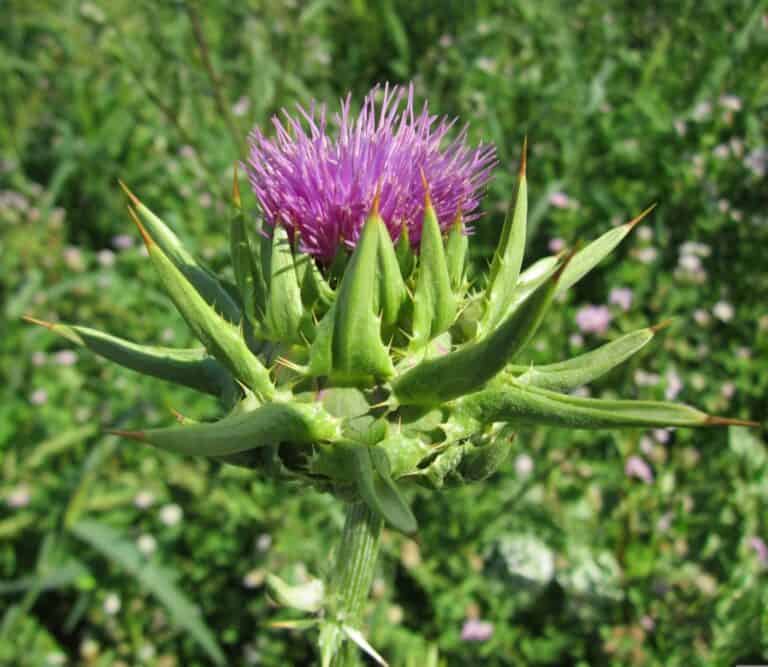
Milk Thistle
Edible Parts:
- Root: Cooked or raw
- Stems of young flowers: Salads, cooked
- Leaves: Once prickles are removed can be eaten raw of cooked
- Flower buds: Cooked
- Seeds: Roasted makes a good substitute for coffee
Nutritional Content:
- Vitamin A, Vitamin C, Vitamin B3, Folate, Calcium, Magnesium, Potassium, Phosphorous, Iron, Sodium
Medicinal Value:
- Used to alleviate liver disorder and damage, including cirrhosis of the liver, jaundice, mushroom poisoning, and chronic hepatitis
- Used against loss of appetite, gallbladder issues, heartburn
- Can also be used against diabetes, spleen diseases, malaria, depression, allergies, and hangovers
- Can be used to increase the flow of breastmilk
When to Harvest:
- Flowers from June to August
Distinguishing Features:
- Grows up to 1 meter with a branched stem
- Takes two years to grow
- Prickly leaves and a uniquely shaped, light-purple flower
Need to Know:
Wear hand protection when harvesting. Read our full article on milk thistle here.
Purslane
Edible Parts:
- Leaves, stems, flower buds: Good cooked in soups, stews, or any other dish
Nutritional Content:
- Omega-3 fatty acids, Vitamin B1, Vitamin B2, Vitamin B3, Vitamin A, Vitamin C, Calcium, Phosphorous, Magnesium, Potassium, Sodium
Medicinal Value:
- Used as an antibacterial, diuretic, and to reduce fevers, detoxify the body, and against scurvy
When to Harvest:
- All summer long
Distinguishing Features:
- Thick, red stem and small, thick, spoon-shaped green leaves
- Grows anywhere there is poor soil, including wasteland, fields, roadsides, and cracks in the sidewalk and roads.
Raspberry
Edible Parts:
- Berries: Raw, jams, jellies, pies
Nutritional Content:
- Vitamin A, Vitamin C, Vitamin E, Vitamin K, Folate, Choline, Calcium, Phosphorous, Potassium, Iron, Magnesium, Copper
Medicinal Value:
- Rich in antioxidants, which provide anti-aging, anti-degenerative, and anti-inflammatory benefits to fight chronic illness
- Lowers blood pressure, and reduces cognitive decline, allergies, diabetes, and cardiovascular disease
When to Harvest:
- Late summer when the berries have become red (or black) and ripe
Distinguishing Features:
- Spade-shaped, toothed leaves, light green on top and light-greenish-silver on the bottom
- Thorns
- Both green and brown canes in the berry patch, indicating the current year’s and last year’s growth
- Look for developing berries that are made of a cluster of small juice sacs
Rose Hips
Edible Parts:
- Fruit: Raw pulp, tea, jelly; can be dried or frozen
Nutritional Content:
- Vitamin C (very high!), Vitamin A, Vitamin B6, Calcium, Magnesium, Iron
Medicinal Value:
- Boosts the immune system, high in antioxidants
- Used to alleviate colds, flu, and scurvy
- Used as a mild laxative, to alleviate kidney disorders, and as an astringent
When to Harvest:
- Fall, after the flower petals have fallen off
Distinguishing Features:
- Rose bush, stems have thorns
- Rose hip is bright red or reddish-orange, round fruit
Need to Know:
- If harvesting around any developed area, be sure there has been no herbicide or pesticide use
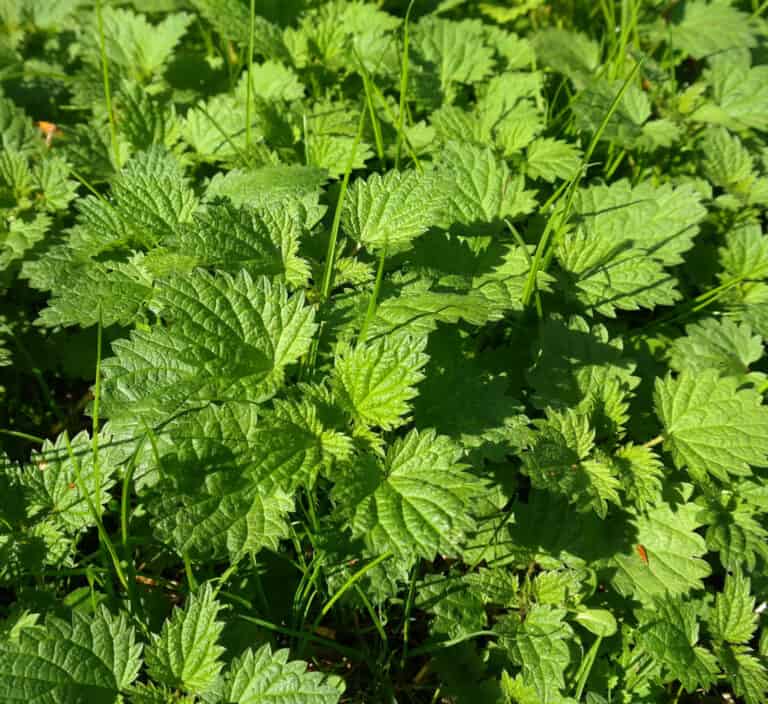
Stinging Nettle
Edible Parts:
- Leaves
- Stems
- Roots
Nutritional Content:
- Vitamin A, Vitamin C, Calcium, Iron
Medicinal Value:
- Used as a diuretic, an astringent, and for joint relief and urination problems associated with the prostate
- Above-ground parts of the plant are used to stop bleeding, to alleviate hay fever and allergies, and to osteoarthritis
- When applied to the skin the above-ground parts of the plant can be used against aches and pains of the skin and muscles, oily scalp and hair, and hair loss
When to Harvest:
- Before the plant flowers
Distinguishing Features:
- Narrow, fine-toothed leaves
- Covered in tiny, sharp, stinging hairs
- Tiny, greenish flowers growing from leaf axils
Need to Know:
- NEVER eat raw
- Cover exposed skin when harvesting
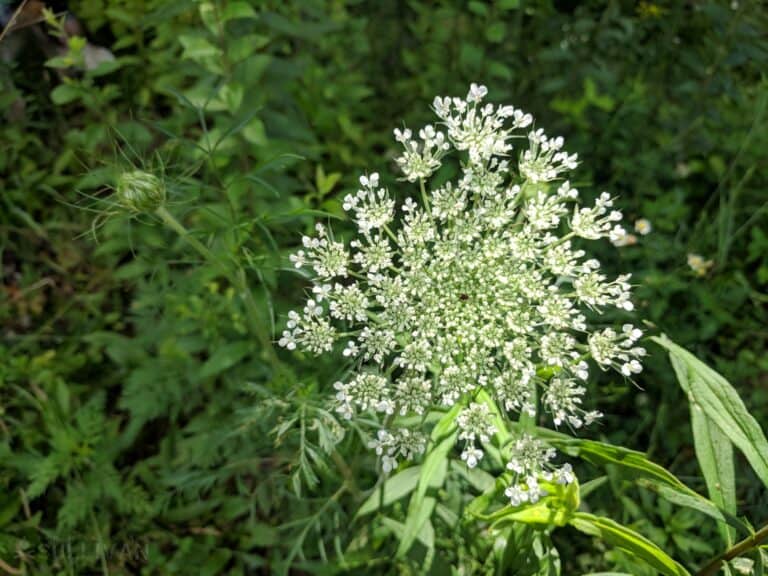
Wild Carrot (Queen Anne’s Lace)
Edible Parts:
- Roots: Soups, stews, tea, sweetener
- Leaves: Salads
- Flowers: Fried, salads
- Seeds: Flavoring for soups and stews
Nutritional Content:
- Vitamin A, Vitamin C, Vitamin B6, Magnesium
Medicinal Value:
- Used to alleviate urinary tract issues, such as kidney stones, water retention, excess uric acid in urine, and problems with the bladder (find out more)
- Oil from seeds used to againstdiarrhea, gas, and indigestion
- Used to alleviate heart disease, kidney issues, and parasites
When to Harvest:
- When flowers bloom and when they go to seed (for the seeds)
- Roots of young plants are the most edible
Distinguishing Features:
- Large, flat cluster of white flowers that resemble lace
- Generally a single dark purple flower in the center
- Roots smell just like carrot
- Feathery leaves, base of leafstalks broad and flat
- Branched stems are hairy
- Grows in fields, meadows, roadsides, waste areas
Need to Know:
- It is recommended you use first-year plants
- Be sure the plant is wild carrot and NOT Poison Hemlock or Fool’s Parsley, which look very much the same
- Poison hemlock and fool’s parsley smell bad; poison hemlock has a smooth, hairless stem
- Poison hemlock can be deadly, so don’t eat it if you aren’t sure it’s wild carrot
Learn more about how to use Queen Anne’s lace here.
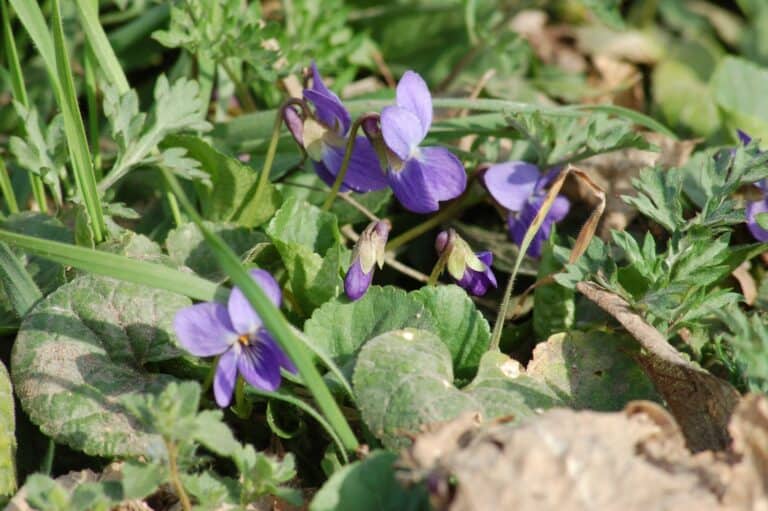
Wild Violet
Edible Parts:
- Flowers: Salads, jellies, candied
- Leaves: Salads, cooked greens
Nutritional Content:
- Vitamin A, Vitamin C
Medicinal Value:
- Leaves are an antiseptic, used in poultices or ointments for bruises and as tea for internal inflammation
- Used against coughs, to calm anger, and as a sleep aid
- Flowers used as a laxative, expectorant, and diuretic
- Roots and seeds used as a purgative; seeds are a diuretic
When to Harvest:
- Early spring into summer
Distinguishing Features:
- Heart-shaped leaves
- Low-growing
- Blue-violet flowers, each flower on its own stalk
- Found long riverbanks, streambanks, in thickets, and woods
Amaranth
Edible Parts:
• All parts of the plant but avoid spines on leaves
Nutritional Content:
• Contains protein, copper, iron, calcium, zinc, manganese, and magnesium
Medicinal Value:
• Offers protein, fiber, and micronutrients and can help reduce inflammation
When to Harvest:
- Seeds ripen three months into the season, so mid to late summer is best
- Harvest when seeds fall from the flowerhead
- Can also harvest leafy greens at any time
Distinguishing Features:
- Can grow to more than six feet tall with alternative diamond or oval leaves that are six inches long
- Grene stems redden as they mature
Need to Know:
- Not poisonous but can contain large amounts of nitrates and oxalic acid
- Boil leaves to remove oxalic acid and nitrates and don’t drink the water after
Curly Dock
Edible Parts:
- Leaves, which taste like lemon
- Seeds and stalks
Nutritional Content:
- More vitamin C than an orange, vitamin A, vitamin B1 and B2, iron
Medicinal Value:
- Used as a purifying and cleansing herb
- Can heal skin conditions
When to Harvest:
- Harvest when leaves are young
- Older leaves should be cooked
- Don’t harvest after leaves are brown
- Stems and seeds can be harvested and cooked at any time
Distinguishing Features:
- Grows 2-5 feet tall
- Has swollen stem joints and hairless leaves
- Stems unbranched below flowerhead
- Narrow leave with curly edges
- Stems turn brown in late summer
- Often grows along roads
Need to Know:
- Also referred to as curly leaf dock, curled dock, and yellow dock
- Contains oxalic acid so don’t overdo it (when raw)
Wild Asparagus
Edible Parts:
- Young stems before leaves form
Nutritional Content:
- Good source of vitamin B6, potassium, thiamine, vitamin C
Medicinal Value:
- Lowers blood pressure, improves digestion, can aid in weight loss
When to Harvest:
- • Harvest when the first spears appear in the spring, about six to ten inches above the soil line but before flowers appear
Distinguishing Features:
- Often found among tall grasses and old growth from the prior year
- Stalks are thin and green with purple or green crowns
- Stalks are firm
Need to Know:
- A commonly cultivated plant but also grows in the wild in most parts of Europe, West Asia, North Africa, and North America
- Has a thinner stalk than cultivated asparagus
- Boil or eat raw like you would regular asparagus
- Stem thickness indicates plant age – thick stems will be older and woodier
Burdock
Edible Parts:
- Most parts, which taste like artichokes
- Leaf stems, flower stalks, roots (remove outer covering of stalks and petioles before cooking)
Nutritional Content:
- Vitamin B6, folate, potassium, vitamin C, manganese, calcium, iron, phosphorous, quercetin
Medicinal Value:
- Reduces fever, kills germs, alleviates colds and GI problems, relieves joint pain, and various skin conditions
When to Harvest:
- Harvest in the fall of the first year, when plant’s leaves are green on top and gray underneath
Distinguishing Features:
- Produces purple flowers in second year of growth
- Has circular cockleburso n the flowerhead
Need to Know:
- Peel and boil the stems
- Don’t plant this plant on purpose – it can become invasive
- Has burrs that can cause discomfort
Clovers
Edible Parts:
- Entire plant
Nutritional Content:
- Contains dietary fiber, protein
Medicinal Value:
- Alleviates hot flashes, arthritis
When to Harvest:
- Mid-August through mid-September
Distinguishing Features:
- Short-lived herb with alternate compound leaves
- Three toothed leaflets
- Small, fragrant flowers in dense heads or pink, red, white, or yellow spikes
Need to Know:
- Edible from root to blossom
- Can be eaten raw but taste better boiled
- White clover in cold climates is generally nontoxic but in warmer climates may be poisonous
Chickweed
Edible Parts:
- Every aboveground part is edible (leaves, buds, stems, flowers)
Nutritional Content:
- Vitamins A, B, D, C, rutin, calcium, zinc, phosphorus, iron, copper, manganese, sodium
Medicinal Value:
- Alleviates constipation, scurvy, psoriasis, itching, stomach problems, joint pain
When to Harvest:
- Right after the rain, ideally first thing in the morning
- May-October is when plant is flowering – best time to harvest if you plan to dry and store it
Distinguishing Features:
- Look for a fuzzy groundcover with tiny white flowers and oval shaped leaves that grow in opposite directions
- Grows close to the ground
Need to Know:
- Tastes a bit like grass
- Leaves can be eaten raw or cooked, just like you would eat spinach
- Can be toxic when fed to animals in large quantities
Field Pennycress
Edible Parts:
- Young leaves
- Seeds can be used as a mustard substitute
Nutritional Content:
- High in vitamins A and C
Medicinal Value:
- Can be used as a blood cleanser and to alleviate arthritis and osteoarthritis
When to Harvest:
Late spring to early summer
Distinguishing Features:
- Rosette of leaves in the fall
- Medium-green leaves that are elongate with long petioles
- Wavy margins on leaves
Need to Know:
- Harvest young leaves early on, before the plant comes into flower, to prevent bitterness
- Has a strong mustard flavor
Fireweed
Edible Parts:
- All parts (leaves, flowers, buds)
- Avoid seeds
Nutritional Content:
- Vitamin C, vitamin A
Medicinal Value:
- used against swelling and pain, fevers, wounds, enlarged prostate, can be made into a tonic or astringent
When to Harvest:
- Harvest early spring shoots at 6-12 inches tall
Distinguishing Features:
- Grows 4-6 feet tall (occasionally taller)
- Long, narrow leaves along the stems
- Unique leaves with circular leaf veins
Need to Know:
- Also referred to as ciilaaq
- Found in forests and fields
- Can be treated like young asparagus when cooking
- Don’t harvest seeds when harvesting leaves
- Great when made into jellies or jams
Green Seaweed
Edible Parts:
- Whole plant
Nutritional Content:
- Good source of iodine, vitamin K, B vitamins, iron, zinc
Medicinal Value:
- Protects thyroid, contains antioxidants
When to Harvest:
- Only harvest when you can safely wade into the shadows
- Best time to harvest is in the late winter to early spring
Distinguishing Features:
- Stem-like stipe on each side that is lined with large blades
- Stems can be thick and rubbery
Need to Know:
- Harvest at low tide on a calm day
Kelp
Edible Parts:
- Whole plant is edible
Nutritional Content:
- Good source of copper, calcium, iodine, zinc, iron, magnesium, vitamins A, D, B1, B2, and C
Medicinal Value:
- Helps fight disease-causing free radicals, prevents oxidative stress, protects cardiovascular health
When to Harvest:
• January to May are best times to harvest
Distinguishing Features:
- No tree-like roots, instead having “anchors” to help it hold on to rocks
- Can be quite large
- Thrives in cold waters
Need to Know:
- Check local restrictions because harvest of kelp is not legal in all places
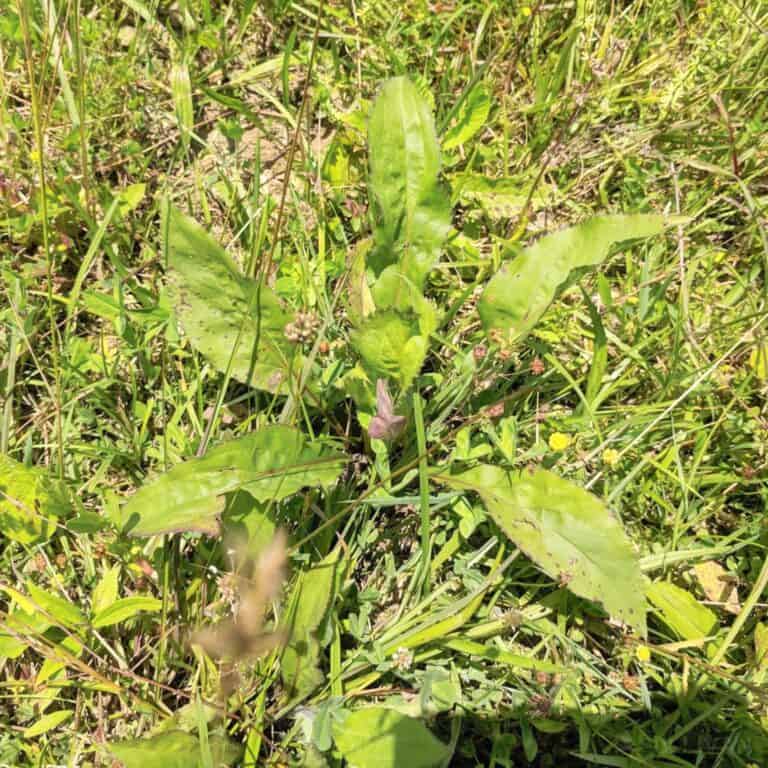
Plantain
Edible Parts:
- Leaves
Nutritional Content:
- Contain anti-inflammatory compounds like terpenoids, flavonoids, tannins, and glycosides
Medicinal Value:
- Used as a remedy for coughs, inflammation, dermatitis, insect bites, wounds, insect bites and stings
When to Harvest:
- • Pick leaves just before flower stalks mature
Distinguishing Features:
- Has ovate leaves with distinctive parallel veins
- Tall green flower stalk
Need to Know:
- Harvest fresh leaves whenever they’re available
- An invasive plant so you don’t have to worry about overharvesting
Prickly Pear Cactus
Edible Parts:
- Fruits
Nutritional Content:
- High in antioxidants, vitamins, and minerals
Medicinal Value:
- Alleviates high cholesterol, obesity, hangovers, diabetes, inflammatory conditions
When to Harvest:
- Harvest in late summer, when fruits are deep magenta with no green remaining
Distinguishing Features:
- Broad, flat green pads
- Spines about three inches long (can be straight, cured, or flat)
- Covered with small barbed hairs
- Green to dark maroon fruits
Need to Know:
- Sweet fruits that can be eaten raw
- Can cause minor side effects like nausea when eaten in excess
- May be difficult to remove small spines
Sheep Sorrel
Edible Parts:
- Leaves
Nutritional Content:
- Vitamins A, B, C, D, K, E
Medicinal Value:
- Diuretic properties, can also be used to alleviate sinusitis
When to Harvest:
- Any time in the spring, summer, or early fall
Distinguishing Features:
- Small yellow or red flowers
- Ridged, succulent flower stem
- Grows as a rosette with small flowers
- Found growing in lawns, fields, parks, and meadows
Need to Know:
- Leaves are similar to field bindweed
- Tastes like citrus or apple
- Contains oxalic acid
Wood Sorrel
Edible Parts:
- Immature leaves, seed pods, flowers
Nutritional Content:
- Rich in vitamin C
Medicinal Value:
- Used to allleviate fevers, scurvy, urinary infections, nausea, sore throat, mouth sores
When to Harvest:
- Anytime in mid-spring to fall
Distinguishing Features:
- Small branches grow at a 90-degree angle to the central stalk
- Looks and tastes similar to sheep sorrel
Need to Know:
- Tastes lemony because of the oxalic acid
- Often confused for clover
- Don’t eat too much in one sitting as it can cause kidney stones or worsen arthritis
Plants to Avoid
If you find yourself in a survival situation and aren’t sure whether the plant in front of you is toxic, it might be best to leave it.
You also should steer clear from plants that have any of the following properties:
- ❌ Milky sap
- ❌ Sap that is discolored
- ❌ Spines
- ❌ Thorns
- ❌ Fine hairs
- ❌ Beans, bulbs, or seeds within pods
- ❌ A soapy or bitter taste
- ❌ Plants that you cannot identify that look like parsnip, dill, carrot, or parsley
- ❌ Plants with an almond-like scent in the leaves and woody parts
- ❌ Grain heads that have black, purple, or pink spurs
- ❌ A three-leaved growth pattern
This checklist might confuse you, since many of the plants we have listed above exhibit these properties.
However, a toxic plant will almost always have one or more of these traits – and so if you aren’t confident in what a plant is, then you should use this checklist to determine if it’s safe. As long as you are sure you know what you’re eating, you’re probably safe.
Still Not Sure if It’s Safe to Eat? Try the Universal Edibility Test
There’s nothing wrong with being overly cautious when it comes to sampling plants you find in the wilderness. It could save your life!
If you still aren’t sure whether you should be noshing on the wild plants you find growing in your backyard forest, consider the universal edibility test. Follow these simple tips.
- Begin by separating the plant out by its parts – the leaves, stems, buds, berries, flowers, roots, etc. Focus on just one part of the plant at a time.
- Give it a good, strong smell. If the plant has an unpleasant odor – particularly one that is very strong – that’s not a good sign. It could be poisonous.
- Next, put a small part of the plant on your inner elbow or your wrist. This is to figure out whether it has any kind of contact poisoning properties. If your skin starts to itch, burn, become numb, or develops a rash, don’t eat the plant (just a word of caution – you may not want to give this tip a try if you are prone to frequent bouts of contact dermatitis or allergic reactions).
- If the plant passes the simple test on your skin, you can prepare a bit of the plant however you intend to eat it. When in doubt, boiling tends to be a good option. However, before you take a single bite, you should try putting the plant to your lips to see if it causes any itching or burning. If you don’t have a reaction within 15 to 20 minutes, you can take a tiny bite. Chew for a while and hold it in your mouth for about 15 more minutes. If it tastes bitter, soapy, or again causes a reaction, spit it out.
- Still no reaction? Great! You can swallow and wait a while. If you still don’t have any side effects within a few hours, the plant is probably safe to eat. Just keep in mind that you may want to repeat this process with all of the various plant parts, since certain plants have both inedible and edible portions.
Final Notes
Wild edibles can provide you with most of your nutritional needs, and when combined with wild-caught meat and fish, will ensure you have a complete and healthy diet. The most important thing to remember, the absolute MUST FOLLOW rule, is that if you are not absolutely sure you know what the plant is, then don’t eat it!
Some plants out there are poisonous and you don’t want to ingest the wrong ones. Start building your wild edible plant identification skills now, so that when you really need the wild food, you’ll know what you are doing and you’ll be safe and well fed.


An urban prepper and rural wannabe, Karen has been working as a freelance writer for a decade and prepping for about half that time. She has gathered a wealth of knowledge on preparing for SHTF, but there is always more to learn and she has a passion for gathering and sharing that knowledge with other like-minded folk. Karen lives in London, Canada with her two children and plethora of cats.

I wish you had given the protein and food value of each plant, as well.
Raspberry leaves are also good for tea and medicine. Many plants now considered invasive were deliberately introduced as edible/medicinal, e.g. plantain, chickweed, kudzu (!). There are many sites that provide good info, e.g. eat the weeds and dave’s garden. There are literally thousands of edible and useful plants. One of the best time investments is learning what is available locally, and how to use it.
After neetles flower you can harvest them, cutting as close to the base as possible. The taller the plant the better.
First remove the leaves, you can still use them in soups although at this stage they can be a bit stringy.
Soak the stems for a few days to soften them, then take 2 stones, one a base stone with a flat surface, the other a rounder stone you can comfortably hold in your hand
Put the stems on the flat stone and use the round stone to crack the outer green pat of the stems open. Inside is a creamy white fibrous part, this is what you want
You can carefully tease these fibres apart and plait them for strings, ropes, etc.
They make excellent snares, nets for fishing & trapping, etc.
Wish there had been photos for more of the plants. But good information.